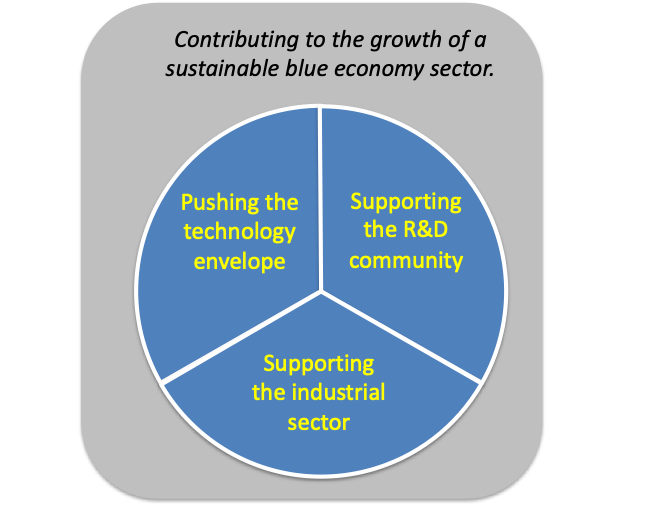Graphical summary
The Infrastructure
The TEC4SEA Research Infrastructure, recognized by FCT in the National Roadmap of Research Infrastructures, is a pioneer platform in Europe to support research, development, and test of marine robotics, telecommunications, and sensing technologies for monitoring and operating in the ocean environment.
The goals
As a direct result of the nature of the founding partners and of the role envisaged for TEC4SEA within the Portuguese National Ocean Strategy (PNOS), this RI was designed to serve not only the academic community, but also the industrial community, fostering and promoting R&D and technology transfer, and helping the intended growth of a sustainable blue economy sector. Its functional objectives can therefore be summarized as follows:
– Supporting the academic community.
– Supporting the industrial sector.
– Foster and promote R&D and technology transfer in maritime technology.
These three pillars contribute to the underlying overarching objective of contributing to the growth of a sustainable blue economy sector.
The nature
TEC4SEA is a geographically distributed infrastructure, with physical presence from the North to the South of Portugal. It is open to the entire scientific and enterprise/industrial community, with a free access policy for researchers affiliated with the research units that ensure its maintenance and sustainability.
In an attempt to rally the vast set of skills, resources and competences needed to successfully tackle the challenge posed by its self-defined mission and, in particular, by the particularly difficulties inherent to the dimension and depth of the Portuguese Sea, the TEC4SEA Research Infrastructure (RI) was created as a highly multidisciplinary platform, capable of supporting research, development, and test of marine technologies. This eclecticism and multidisciplinary nature, required for the effective and self-sustained development of technologies for monitoring and operating in the ocean environment, are well reflected in the diversity and scope of the defined scientific objectives defined in its roadmap.
TEC4SEA is a vertically integrated infrastructure, in the sense that it possesses a set of skills and resources ranging from pure conceptual research to sea going missions, with strong industrial and logistic competences in the middle tier of prototype production. It can thus support researchers in all phases of technology development, from conception and theoretical analysis, to prototype development, field test deployments, and technology validation. This large scope in the nature of the TEC4SEA activities is again well reflected in the diversity of the defined scientific objectives defined in its roadmap.

Motivation
The drive to develop technology for the ocean environment is not the only driver of TEC4SEA. Equally important, and identically ingrained in its founding DNA, is the recognition that the usefulness of technology is measurable by the impact it has on the surrounding economic and social fabrics. As such, TEC4SEA attributes high priority to programs and projects with the potential to empower participating private companies, by increasing their capacity to innovate in the sea economy arena.
Being technical education a vital component of the technological empowerment of industry and, in general, a key factor in the technological capabilities of societies, the TEC4SEA infrastructure is also highly committed to the provision of advanced education programs.
Strategic Alignment
A great deal of effort was also put into guaranteeing that the scientific roadmap of TEC4SEA was kept aligned with the Portuguese National Ocean Strategy (PNOS), so that it might become an useful asset for the promotion of national blue growth. The NPOS was not, however, the only national strategy which was considered.
At the European level, the alignment is also completely preserved. Being deeply rooted in the Atlantic Ocean, the largest sea basin in terms of gross value added (GVA), it directly addresses an assets representing 36% of the EU blue economy GVA. Since the new PNOS was already fully aligned with the European relevant documents, namely the European Commission’s Atlantic Maritime Area, and given TEC4SEA´s capability to address to address and support the challenges of all four pillars of the Atlantic Action Plan 2.0, the strategic alignment at the national level mostly implied the alignment at the European level.
As a result of this alignment, all orientations and choices present in TEC4SEA’s Scientific Roadmap are direct consequences of both the geostrategic nature of Portugal as a maritime axis Nation, and of the particular characteristics of the Portuguese Sea.
Mission, Vision, Values, and Strategic Objectives
The strategic objectives are organized in the map according to their different nature:
Perceived value: Related to how we want to be seen
Operational: Related to what we want to do
Structural: Related to how we want to be organized, in terms of structural design
Genetic: Related to what new capabilities we want to build.
Main research areas
- Marine robotics, addressing the development of solutions for long term deployments, deep water operations, autonomous inspection and intervention, intelligent data harvesting, and safe operation of unmanned platforms;
- Technologies and systems for underwater monitoring, namely fiber optic sensors and imaging systems for measuring physical, chemical and biological parameters and enabling smart infrastructures;
- Broadband wireless communications systems for ocean environments, including radio systems for over water communications and acoustic, optical, and radio systems for underwater communications;
- Acoustic systems for ocean monitoring and exploration.

